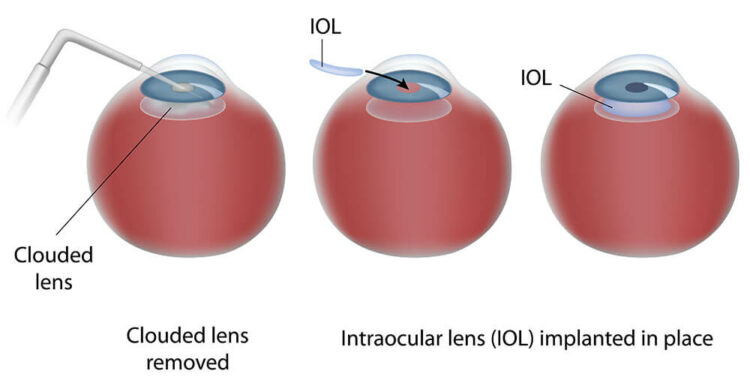Home | Cataracts | Lens Options
Lens Options
What Are Intraocular Lenses?
The eye’s natural lens is removed during cataract surgery. Intraocular lenses (IOLs) are small medical devices implanted inside the eye to replace the eye’s natural lens.
They resemble a contact lens. There are several kinds of intraocular lenses (IOL’s). Each is safe and approved by the F.D.A. for use in the United States.
Will I Still Need Glasses After Cataract Surgery?
During traditional cataract surgery, the eye surgeon will place a monofocal lens in your eye. Monofocal lenses are the most basic kind of IOL available.
This is the only kind of IOL that insurance will pay for. It only corrects for one range of vision, and most people choose the ability to see clearly at a distance.
Many patients are thrilled that they can drive or see a performance without glasses after cataract surgery. But they will need glasses to see up close, including reading or texting on their smartphone.
What Are Premium Lenses?
Thanks to advances in technology, cataract patients can now see near, far, and in-between after surgery. With premium intraocular lenses (IOLs), many of our patients can enjoy clear distance vision.
They can see clearly at a distance while reducing or eliminating the use of reading glasses. Some premium lenses can even correct the problems of blurry or distorted vision caused by astigmatism.
When you are ready to plan your cataract surgery, your Joshi Eye Institute surgeon will explain the options available. It’s important to discuss your lifestyle and favorite activities so that they understand your priorities.
If you love sports and outdoor activities, you may want an option that minimizes wearing glasses. If you spend more time on a computer, you may want to consider a different lens option.
Premium IOLs are not covered by Medicare or other insurances. The reason for this is because they are not considered medically necessary.
If you want premium lenses, your procedure is still covered but you will need to pay out of pocket for the lenses. The staff at Joshi Eye Institute can explain the options, as lens costs vary.
Is It Possible To Use A Different Type Of IOL In Each Eye?
Yes. Sometimes, the best visual outcome after cataract surgery occurs if there is a different kind of premium IOL in each eye. For example, you may have more astigmatism in one eye than the other.
Your surgeon might recommend a toric IOL for that eye, and a different type of IOL for the other eye.
How Can I Decide Which Premium IOL Is Best For Me?
Your Joshi Eye Institute eye surgeon will discuss the various IOL options during your cataract screening. Each premium IOL has advantages and disadvantages.
If safe driving at night is your top priority, there are some IOLs that are better in low light and reducing glare.
Other IOLs may be best for achieving some near vision correction. Your doctor will recommend the best solution for you.
Concerned that you may need cataract surgery? Schedule a cataract screening at Joshi Eye Institute in Boynton Beach, FL!








